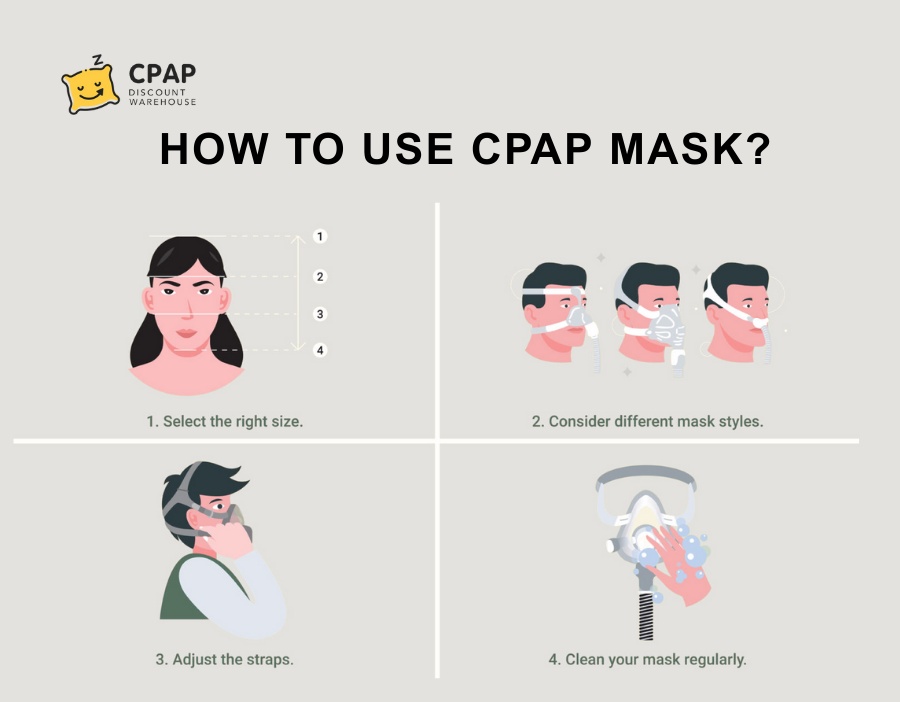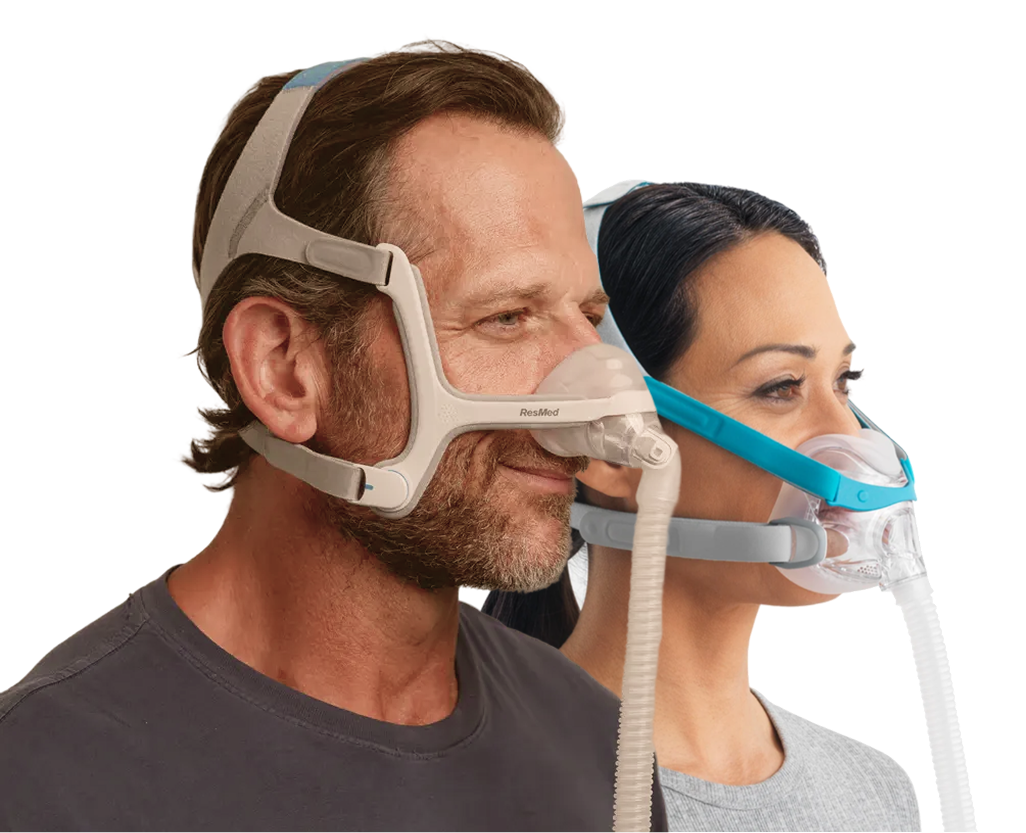The nasal pillow mask provides an excellent combination of stability, comfort, and ease of use, allowing patients a sense of facial freedom during CPAP therapy. Its innovative design includes elastic headgear with minimal facial contact, promoting easy patient acceptance and offering a secure yet discreet fit. For those learning how to use Nasal Mask CPAP from CPAP Discount Warehouse, proper use and maintenance are essential for ensuring its effectiveness and longevity.
What types of CPAP mask do you have?
The CPAP masks differ in size and style, with the main difference being which part of the face is covered. A nasal pillow mask sits at the entrance to the nostrils, while a nasal mask covers the nose and a full face mask covers both mouth and nose.
Nasal mask send pressurised air through your nose while keeping your mouth free. Most nasal masks cover the whole nose, from the bridge of the nose to above the upper lip, but some nasal cradle masks leave most of the nose exposed. The text is now simpler.
Nasal CPAP masks are one of the most popular types of CPAP mask and are suitable for many people. Nasal masks that are not as bulky are great for people who wear glasses or like to watch TV before bed. The text is now simpler.
A nasal pillow mask gently blows air into your nostrils to seal them, which directs air through your nose while keeping your skin away from it. The text is now simpler.
Nasal pillow masks are the lightest and most streamlined of all CPAP mask styles. This makes them a popular choice for people who find other masks claustrophobic. They can also help you sleep better on your front or side. The text is now simpler.
Full face mask send air in and out through your nose and mouth. Most of these start at the bridge of your nose and end below your lower lip, but some compact versions leave most of your nose free. The text is now simpler.
Full face CPAP masks are the best choice for people who breathe through their mouths while they sleep. They are also more comfortable than most nasal styles for high air pressure prescription.
We recommend that you contact your sleep consultant to try out different mask styles and choose the one that suits you best.

>>>> What Are The Different Types Of CPAP Masks Available?
Parts of the CPAP Mask
Your CPAP sleep apnea mask has several different parts, all of which can be replaced by your CPAP supplier. They are:
+ Headgear: All masks require some sort of headgear, including straps, to secure them in place.
+ Tubing: All CPAP masks come with a length of tubing that attaches to the box on one end. The other end of the tubing secures to your mask, delivering continuous air pressure. Tubing is usually six feet long so you can make around in your sleep.
+ Chin Strap: is the optional attachment that helps to keep your mouth closed when you're wearing your mask.
+ Cushion: To make the fit as comfortable as possible and to reduce skin irritation, all sleep apnea masks are cushioned in the spots where the mask comes into contact with the face. This cushioning also improves the seal, minimizing air leaks.
+ Connectors: the tube-shaped connectors that join the CPAP mask to its tubing.
>>> How to use CPAP machine step by step?
How to use CPAP Masks?
The more often you use your CPAP masks, the easier and more natural it will feel to put on. In the beginning, you may find it helpful to practice in front of a mirror so you can clearly see what you’re doing.
Step 1: Assemble the Mask
Make sure your mask is clean and fully assembled before use. Most manufacturers provide step-by-step assembly instructions with the mask or on their official website.
Step 2: Position the Mask
Proper positioning depends on the mask style:
+ Nasal masks should sit gently on the bridge of your nose without gaps or extra pressure, and rest above your upper lip without blocking your nostrils.
+ Nasal cradle masks should fit neatly between your nostrils and upper lip without pressing uncomfortably.
+ Nasal pillows insert directly into the nostrils and should appear even and balanced when viewed in a mirror.
+ Full face masks should be centered between the bridge of your nose and the middle of your chin. Compact versions should not press on your upper teeth or nostrils.
Step 3: Secure the Mask
Once the cushion or pillows are in place, adjust and secure the headgear following the manufacturer’s directions.
+ A proper fit should be snug but not tight.
+ Avoid over-tightening, which can actually cause leaks and discomfort.
+ The mask should remain stable when you move your head or change sleeping positions.
Step 4: Attach the Tubing
Most CPAP tubing uses a standard 22-millimeter cuff that fits securely over the mask port. Flexible cuffs are often easier to handle than rigid ones, so consider using a soft adapter if your tubing has a hard cuff.
Step 5: Check for Leaks
Turn on your CPAP machine and verify your settings. Signs of a leak include:
+ A sharp or loud hissing noise
+ A noticeable stream of air against your skin or near your eyes
+ A leak alert from your CPAP machine (if available)
Step 6: Make Final Adjustments
If you notice leaks, the mask may be too loose, too tight, or not positioned correctly. Try adjusting the headgear straps. If that doesn’t work, remove the mask and reposition it before securing it again.

>>> Why does my CPAP mask get water in it?
FAQs
How can I improve the fit of my CPAP mask?
Try moving the pads and straps to get a better fit. If you put the mask on, make sure it doesn't go too high on your nose, as this can push air into your eyes. If you have lost or gained a lot of weight, you may need to ask your CPAP supplier to help you find a different size mask.
How do I stop my CPAP mask from leaking?
It's also important to keep your equipment clean. Make sure your mask and cushion are fresh and clean. If you regularly replace worn parts like cushions and headgear, you can make sure that the seal stays good. If the leaks continue, think about using a CPAP mask liner to make it more comfortable and to improve the fit.
How tight should CPAP headgear be?
Tighten your headgear straps evenly to make it comfortable. If you can only get a good seal by tightening the mask until it's uncomfortable, you may have the wrong size. If you tighten your straps too much, they might leak. So it's important to fix this.
How to make a CPAP mask quieter?
Here are some quick ways to reduce noise during CPAP therapy:
+ Check and adjust the mask so that there are no air leaks.
+ Make sure the hose is connected properly and there are no bends or kinks.
+ Replace any parts that are worn out, such as filters or the seal around the water chamber.
+ Move the CPAP machine to a different place to reduce noise.
How to properly fit your CPAP mask?
Refer to the CPAP mask sizing guide provided by the manufacturer here
How do I know if my mask has a magnetic connector?
The manufacturers wrapping should clearly say if the masks use magnetic connectors.
In conclusion, understanding how to use nasal mask CPAP, including proper fitting, adjusting, cleaning, and maintaining the mask, is crucial for ensuring its longevity and effectiveness, enabling patients to enjoy optimal comfort and results with minimal effort.






